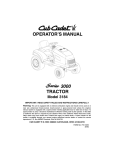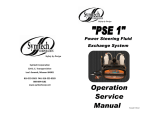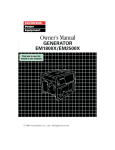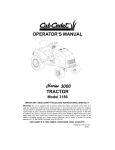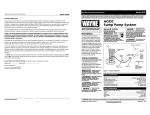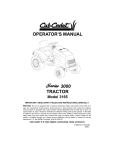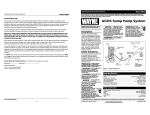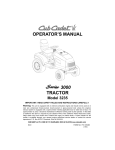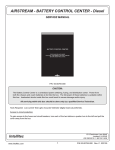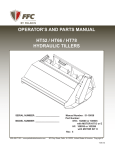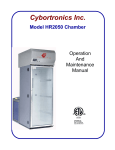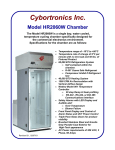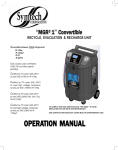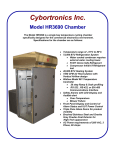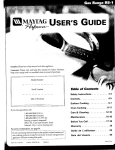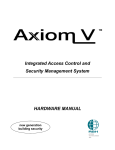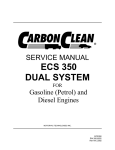Download manual - Symtech Corporation
Transcript
Safety by Design OPERATION MANUAL Automatic Transmission Fluid Exchanger Rev. 6/14/12 Table of Contents Introduction…………………………………………………………………… 2 Initial Battery Charging………………………………………………………. 2 Safety Precautions………………………………………………………. ……. 3 Protective Cover Warning…………………………………………………….. 3 Before Starting ......................................................................................................3 Battery Charger Profile/Cautions…………………………………………….. 5 Control Panel Descriptions and Functions .........................................................7 MODES of OPERATION Cooler Line Exchange .......................................................................................... 9 Cooler Line Exchange Process, Easy Reference ..................................... 11 Dipstick Exchange............................................................................................... 12 Dipstick Exchange Process, Easy Reference ........................................... 13 Drain Pan, Filter Changes, or Other Services ................................................. 14 System Filter Service .......................................................................................... 14 Empty Used and Empty New Tanks ............................................................14/15 Empty Hose and Dipstick Wand Drippage ...................................................... 15 Adapter List ......................................................................................................... 16 Battery Charger Specifications………………………………………………. 17 Periodic Maintenance………………………………………………………… 17 Frequently Asked Questions……………………………………………… 18/19 Warranty Statement / Commitment ................................................................. 20 1 Introduction Thank you for purchasing Symtech Corporation’s ATF1 Automatic Transmission Fluid Exchange System. The ATF1 is state of the art and incorporates the latest technology and techniques to quickly perform all required periodic maintenance services for automatic transmissions. It is extremely easy to operate, environmentally safe, and designed for the highest efficiency. The Operations Manual MUST be read and COMPLETELYUNDERSTOOD in order to properly operate the unit and experience the highest return on investment. Refer to the manual in the future for continued safe operation. If you encounter difficulties in the operation, understanding of procedures, or have general service questions, please do not hesitate to call us at 888-884-8182. Please record the purchase date, serial number and distributor purchased from below for future reference and assistance on technical issues. Purchase Date:_______________________ Serial Number:_______________________ T1Located on Back of Unit Purchased From: __________________________________ __________________________________ __________________________________ Initial Battery Charging (no less than 4 hours) Prior to performing the first transmission fluid exchange, it is recommended to charge the battery for eight (8) to ten (10) hours before operating the ATF 1 for the first time by plugging the power cord into a 110VAC power source. 2 SAFETY PRECAUTIONS WARNING: FAILURE TO FOLLOW PRECAUTIONS CAN RESULT IN INJURY OR DEATH Always use extreme caution and forethought when servicing automotive systems! Automotive systems are extremely hot and contain high pressure. Always read and understand the entire Operations Manual before operating! Always wear proper eye and skin protection when operating equipment! Always keep fire extinguisher nearby for flammable conditions! Always keep hair, loose clothing, hoses, etc. securely away from moving parts! Always keep work area well ventilated to prevent carbon monoxide build up! Always comply with local, state, and federal regulations concerning fluid! Always clean up and report spill in a proper manner! Always read and understand the Material Safety Data Sheets (MSDS) for particular fluids! Always seek emergency medical attention for ingestion of, or eye contact with fluid! BATTERY SAFETY Lead-acid batteries commonly used in vehicles, and in the ATF1 unit , can be highly dangerous if the proper precautions are not taken while working in the vicinity of the battery. Batteries generate explosive hydrogen gas during normal operation that may ignite in the presence of sparks, flames, or smoking! Always have the Main Power switch of the unit in the off position when making connections to avoid sparks. Connecting the negative (black) power clip to a suitable system ground away from the battery and never to the negative post of the battery provides additional protection from explosive hazard. WARNING WARNING DO NOT store / stage ATF 1 outside during inclement weather such as rain DO NOT Store / Stage ATF 1 outside during inclement weather such as rain or snow and/or being snowcovered without covered by aWater protective Water induced without bybeing a protective device. induceddevice. into pumps will void into pumps willshorten void warranty greatlyand shorten life cycle offluids. equipment warranty, greatly life cycle ofand equipment could contaminate and could contaminate fluids. TO ORDER PROTECTIVE COVER P/N: 30116005 Call 1-8888-884-8182 Before Starting 1. Adjust the transmission fluid level according to the manufacturer’s instruction. Be aware that some vehicles require the fluid level to be checked in “PARK” and some in “NEUTRAL.” The COOLER LINE mode of service will also be done in the same manner as checking transmission fluid levels. 3 WARNING: TAKE NECESSARY PRECAUTIONS TO SECURE THE VEHICLE WHEN CHECKING TRANSMISSION FLUID LEVELS OR PERFORMING SERVICES!! 2. NEVER put anything but automatic transmission fluid in the NEW tank of the ATF1 . If transmission Flush Additive is to be used, it should be added and circulated in the transmission prior to exchange or drain pan functions being performed. 3. Always use the proper type of automatic transmission fluid for the vehicle being serviced. Refer to the vehicle’s Service Manual or dipstick for information on the type of fluid to be used. NOTE: Refer to the EMPTY NEW tank procedures on page 13for information on how to change fluid types in the unit. 4. The ATF1 is designed to operate on regulated 12V DC power ONLY from either the vehicle’s battery or the unit’s on-board battery. Use of battery chargers and other power sources are not recommended. 5. Pull on all of the connections after being made in order to verify that the connections are complete and secure. 6. Only use fingertips to depress control panel buttons. Sharp, or pointed metal objects will ultimately destroy the control panel. 7. Always keep the ATF1 unit in the upright position and as level as possible during operation. Inverting or lying the unit down will allow fluids to escape the internal tanks. Operating the unit on a level surface will insure precise operation. 8. Some transmission pumps do not create enough flow or pressure at idle to properly, or efficiently, perform the COOLER LINE transmission services. Examples are Ford Explorers and Dodge Caravans. Accelerating the vehicles engine above idle will remedy this problem. 9. Turn the ATF1 Main Power switch OFF when not in use to conserve power and prevent accidental start up. 10. Always connect power cables ofATF1 to 12V DC battery of vehicle to be serviced. Although the fully-charged on-board battery will power the ATF1 exchanger, the primary purpose of the on-board power is for the resume-refill procedure, drain used tank procedure, and emergency power back-up to avoid service interruptions. The power leads should always be connected to the vehicle’s 12V DC battery during each service to keep on board battery fully charged and ready for intended purposes. 11. NEVER overfill the NEW fluid tank over 31.5 quarts. The ATF1 will lock out all keypad functions except EMPTY NEW and display “too FUL” when it detects 32.0 quarts in 4 12. To exit the too-full mode, connect one of the intermediate hoses to the end of the new fluid hose and connect an open fitting from the adapter tray to the other end of the intermediate hose. Direct the end of the intermediate hose to a suitable container to catch the excess new fluid and press and hold the EMPTY NEW button until the new fluid pump begins to run. The unit will automatically reset once it detects less than 31.7 quarts in the new fluid tank. 13. To exit the too-full mode, connect one of the intermediate hoses to the end of the new fluid hose and connect an open fitting from the adapter tray to the other end of the intermediate hose. Direct the end of the intermediate hose to a suitable container to catch the excess new fluid and press and hold the EMPTY NEW button until the new fluid pump begins to run. The unit will automatically reset once it detects less than 31.7 quarts in the new fluid tank. Battery Charger Profile/Cautions 1. The ATF 1 battery charging system will operate from any 110VAC power source. 2. When charging system is plugged into a 110 VAC power source, a red led will illuminate through the rear of top to indicate that system is charging, NO red light indicates that battery is at full charge. 3. A three prong, grounded, heavy duty extension cord or receptacle is recommended if power cord is not of sufficient length to connect to a 110VAC receptacle. 4. The battery charger should only be operated in temperature range of 15 o-100o F. 5. The battery charging system should only be operated when relative humidity is below 90%. 6. The battery charging system should only be operated with the Symtech power cord (Part number: 30110317) provided with the ATF 1 accessory kit. NOTE: Though the ATF 1 is equipped with an on-board charging system, it is highly recommended that the ATF 1 battery terminals be connected to the vehicle battery during all flushing functions; this will greatly extend the life of the onboard battery. 5 CONTROL PANEL LAYOUT 1. NEW Fluid TankReadings 2. USED Fluid Tank Readings 3. INCREASE Fluid Amount 4. DECREASE Fluid Amount 5. POWER ON LED 6. STOP System Button 7. QUARTS / LITERS Mode 8. COOLER Line Mode 9. FLUID EXCHANGE Start 1 3 10. Reverse Polarity Warning 5 6 4 8 10 9 11 2 7 12 11. Process READY Indicator 12. DIPSTICK Mode 15 13. EMPTY NEW Tank Function 14. LOW Fluid Level Warning 15. DRAIN PAN Function 13 16 19 16. RESUME REFILL Function 17. REMOVE FLUID Function 17 18. ADD FLUID Function 19. EMPTY USED Tank Fluid Function 14 18 20 20. HIGH Fluid Level Warning On Board Battery Power Saving Mode The ATF1on board battery is very similar to any other cordless tool with a battery. The more it is slowly charged at a low rate the better the charge and longer the battery life. The ATF1has a power saving mode that protects and prevents operation of the unit under 11volts DC. LCD readouts will display “LO BAt” and the keypad will be non-functional until the unit is connected to a 12volt DC supply and main power is switched off and then back on. Charging the on board battery after every three to four transmission flush services with the on board battery charger will greatly extend the life of the battery. 6 Control Panel Descriptions and Functions The following information is intended to familiarize the ATF1operator with the control panel and its functions. It is not designed to replace the guidelines and safety warnings found in the remainder of this document. The complete Operations Manual and Warnings must be read and understood before operating the machine. Failure to follow these instructions could endanger the operator and risk damage to the vehicle. The NEW tank values and functions are displayed and performed on the top left of the panel, while the USED tank values and functions are displayed and performed on the top right of the panel. (See page 5) There are two modes of service that can be performed, COOLER LINE mode on the left side of the control panel and DIPSTICK mode on the right side. The exclusive EXCHANGE START function is also on the left, while the shared functions between both modes of operation are located down the middle of the control panel. Exchanges Decide which mode of exchange will be performed, either the traditional COOLER LINE mode or the DIPSTICK mode. This unit allows the service technician or the customer to decide what mode of service will be performed and it is fully capable of performing the various functions required in either mode. The operator starts at the top and works down the control panel. Look at the display upon power up to view tank levels, to select mode of operation (COOLER LINE or DIPSTICK), to adjust Quart/Liter amounts of fluid as required, to start functions to be performed, to verify function completed, and to continue to the next function if needed. 1. NEW Fluid digital display – Displays the amount of NEW transmission fluid in the NEW tank when no modes are selected. It also displays the amount of fluid to be exchanged, added, removed, or the decreasing amount of NEW fluid being pumped from the unit. Amounts are displayed to the nearest tenth in quarts or liters dependent upon unit of measure selected. The display decreases in value for the NEW fluid being pumped out of the unit and increases in value as the desired fluid amounts are keyed in or set for the various functions. 2. USED Fluid digital display – Displays the amount of USED transmission fluid in the USED tank when no modes are selected. In all modes and functions, the USED fluid display indicates increasing amounts of fluid being extracted from the vehicle during the process selected. Amounts are displayed to the nearest tenth in quarts or liters dependent upon unit of measure selected. The display decreases in value for the USED fluid being pumped out of the unit and increases in value as the desired fluid amounts are keyed in or set for the various functions. 3. “+“Increase Button – Adjustment button used to increase the amount of fluid, in tenths, of a quart/liter to be transferred in each applicable mode and function. 4. -“Decrease Button – Adjustment button used to decrease the amount of fluid, in tenths, of a quart/liter to be transferred in each applicable mode and function. 7 5. POWER – Indicates that 12V DC power with a negative ground, either internally via onboard battery, or externally via power cables, has been supplied to the unit through the Main Power switch. 6. STOP – Button used to stop all modes and functions at any time. NOTE: If unit is stopped during an exchange, all exchange amounts will be lost. 7. “ Q/L ” QUARTS/LITERS – Selection button and indication LED’s used to select and depict the required unit of measure for volume measurements. Can only be utilized before mode selection. 8. COOLER LINE – Mode selection button and indicator LED used to select and depict the COOLER LINE mode of operation. This mode is selected when intercepting transmission cooler lines to exchange, extract, and replenish fluid through the vehicle’s transmission cooler lines. (COOLER LINE can only be selected when pressure from the vehicle is detected) 9. EXCHANGE START – Function selection button and indicator LED used only in the COOLER LINE mode in order to start the exchange of new transmission fluid for old transmission fluid through the vehicle’s transmission cooler lines. 10. REVERSE POLARITY – Light that indicates that the battery connections to the vehicle are reversed and that they need to be corrected before the unit will receive external power. A continuous alarm accompanies the light as long as the incorrect connection exists. 11. READY – Illumination of the READY light indicates that the unit has completed the selected function and will require attention or input from the operator in order to continue. The READY light is accompanied by short beeps or continuous alarms, depending upon the function completed, in order to further alert the operator. 12. DIPSTICK - Mode selection button and indicator LED used to select and show the DIPSTICK mode of operation. This mode is selected when using the vehicle’s dipstick tube to exchange, extract, add transmission fluid with the ATF1unit.The transmission filter can be serviced at this time as well. 13. EMPTY NEW – Function selection button and indicator LED used to start and shows when NEW transmission fluid is being pumped from the unit. Selection of this function empties the new fluid out through the RED hose, and stops when the tank level nears zero. See page 13 for complete instructions. 14. LOW TANK LEVEL – LED that indicates when the NEW tank fluid quantity is inadequate to perform the selected function, or that the NEW tank level is below one quart. The appropriate amount of new fluid must be added to the NEW tank when this LED is lit. 15. DRAIN PAN – Function selection button and indicator LED used to start and depict when draining the vehicle’s transmission sump via the DIPSTICK mode. The LED lights and remains lit in DIPSTICK mode until function is complete. 16. RESUME REFILL – Function selection button and indicator LED used to start and depict the refilling of the vehicle’s transmission sump after a DRAIN PAN procedure has been performed. The LED lights to prompt operator and remains lit until the process is complete in DIPSTICK mode. 8 17. REMOVE FLUID – Function selection button and indicator LED used to select the function and to start the removal of used fluid process after amount input via the COOLER LINE or DIPSTICK mode. 18. ADD FLUID - Function selection button and indicator LED used to select the function and to start the addition of new fluid process after amount input via the COOLER LINE or DIPSTICK mode. 19. EMPTY USED - Function selection button and indicator LED used to start and depict USED transmission fluid being pumped from the USED FLUID tank Selection of this function empties the old fluid out through the large hose with the ball valve. This process stops when the USED FLUID tank level indicates zero. See page 13 for complete instructions. 20. HIGH TANK LEVEL–Lit LED indicates when the USED tank fluid quantity is inadequate to perform the selected function, or that the USED tank level is above 31 quarts. The USED fluid tank level must be lowered or the tank emptied when this LED is lit. MODES of OPERATION Cooler Line Exchange **NOTE: VEHICLETRANSMISSION FLUID SHOULD BE AT OPERATING TEMPERATURE PRIOR TO PERFORMING ANY SERVICE WITH THE ATF1. **NOTE: THE ON BOARD BATTERY SHOULD BE AT FULL CHARGE FOR MOST EFFICIENT FLUID EXCHANGE SERVICE, make it a habit to plug the on board battery charger into a 110 volt service outlet after every 3 to 4 fluid services for efficiency and extended battery life. 1) Identify the correct cooler line adapters from the vehicle application chart located in the operations manual. Properly connect the adapters to the most convenient and accessible cooler line on the vehicle. The ATF1requiresjust one cooler line to perform the exchange, it does not matter which line is selected. 2) Connect the adapters to the most convenient intermediate hose. Included are one straight and one ninety-degree intermediate hose. Connect the red new fluid line from the unit to one of the transmission intermediate hoses. Connect the black used fluid line from the unit to the remaining intermediate hose of the transmission. It does not matter at this time if the new or used line is connected to the wrong side of the transmission coolant line as it will be corrected in step #4. 3) Connect the ATF1to the vehicle’s 12v battery, making sure to observe all applicable safety precautions. Should the connection inadvertently be reversed, REVERSE POLARITY light will be lit, along with a steady audible alarm, until the correct connection is made. Once correct battery connection is made, turn Main Power switch to the ON position. Alarm will sound for two seconds, all of the LED’s will momentarily turn on, the POWER and READY lights will turn on and the NEW and USED readouts will display quantities of corresponding fluid in each tank. If fluid in the NEW tank is low or the fluid in the USED tank 9 is high, take the appropriate steps at this time to add NEW, or empty USED fluid(s). See page 13 for instructions. Note: The unit defaults to QUARTS measurement upon start up. LITERS may be selected by depressing the “Q/L” button. The LED indicates which unit of measure is being utilized. 4) Start vehicle. Fluid pressure should now increase on the pressure gauge located on the front panel of the unit, the READY light will remain on, and a continuous alert indication will sound. WARNING: If zero pressure is displayed on the pressure gauge and the continuous alert does not sound upon vehicle start up, then IMMEDIATELY turn the vehicle off and switch the new and used hose connections at intermediate hose locations. Once the hoses have been switched, repeat the above procedure and verify that READY light comes on and alert indication sounds. This indicates that the proper connections have been made and the fluid is flowing in the right direction. Unit is now in bypass mode with fluid simply flowing through the unit and returning to vehicle. Alert buzzer indication will continuously sound until COOLER LINE mode is selected. To silence alert, select COOLER LINE mode or turn off the vehicle. 5) Select COOLER LINE mode. LED will turn on and remain lit, the continuous alert will stop, READY light will remain lit, NEW tank readout defaults to 12 quarts. 6) Set the amount of fluid to be exchanged in one-tenth quart or liter increments, increasing or decreasing the volume by depressing “+” or “-“ buttons until the desired quantity to be exchanged is reached. This amount will be displayed in the NEW fluid readout on the top left of the control panel. 7) Press EXCHANGE START. READY light will go out and the value on the NEW fluid readout will begin to decrease as new fluid is being pumped into the vehicle. Amount shown in the NEW fluid readout also represents the remaining amount of new fluid left to exchange. USED fluid readout will begin to increase from zero as the USED fluid from the vehicle enters the USED fluid tank of the unit. The USED fluid readout depicts amount of USED fluid removed from the vehicle during exchange. NOTE: If NEW fluid tank does not have enough fluid to perform the exchange or USED fluid tank does not have enough capacity to perform the exchange, appropriate LED will light and beep indicating LOW TANK LEVEL in NEW tank and/or HIGH TANK LEVEL in USED tank. Take the appropriate actions to correct fluid levels and repeat Steps 3-7. The STOP button must be pushed to reboot system. See page 13 for instructions. NOTE: Should pressure drop below 4 psi during exchange for any reason, the ATF1defaults to a bypass circuit and a continuous alarm will sound to alert that the exchange has stopped. Upon correction of the problem, process will require restating from step #4. 8) Upon completion of the fluid exchange, alarm will sound, READY light will turn on, and unit will automatically go into bypass mode. 10 9) Check vehicle’s transmission fluid level. Add or extract fluid to obtain the proper fluid level by selecting COOLER LINE mode. Select appropriate ADD FLUID or REMOVE FLUID button on the control panel. READY light will turn on when either function is selected while awaiting an amount to be entered on the corresponding display using the “+” or “- “ buttons of the control panel. READY light will turn off and the proper amount of fluid will be added or removed after pressing the ADD FLUID or REMOVE FLUID button the second time. The unit resetting signals the completion of fluid additions and removals and continuous alert will sound until vehicle is turned off or COOLER LINE mode is selected. Repeat procedure if necessary by selecting the COOLER LINE function again and performing this step as required in order to obtain proper fluid level. NOTE: If NEW fluid tank does not have enough fluid to perform the ADD FLUID function or USED fluid tank does not have enough capacity to perform the REMOVE FLUID function, the appropriate LED will light and beep indicating LOW TANK LEVEL in NEW tank and/or HIGH TANK LEVEL in USED tank. Take appropriate actions to correct fluid levels and then repeat step 9. See page 13 for instructions. 10) Shut off vehicle. Disconnect hoses and adapters, reattach transmission cooler lines to original connections, start vehicle to check for leaks, and recheck the transmission fluid level. COOLER LINE exchange is now complete. Cooler Line Exchange Process, Easy Reference **NOTE: VEHICLETRANSMISSION FLUID SHOULD BE AT OPERATING TEMPERATURE PRIOR TO PERFORMING ANY SERVICE WITH THE ATF1. **NOTE: : THE ON BOARD BATTERY SHOULD BE AT FULL CHARGE FOR MOST EFFICIENT FLUID EXCHANGE SERVICE, make it a habit to plug the on board battery charger into a 110 volt service outlet after every 3 to 4 fluid services for efficiency and extended battery life. Preparation: 1. Identify correct adapters, one male, and one female. 2. Locate most convenient transmission cooler line, disconnect cooler line, connect adapters. 3. Connect adapters to intermediate hoses and connect ATF1RED hose to one intermediate hose and BLACK hose to other. Operation: 1. ConnectATF1to vehicle battery. 2. Turn on Main Power. 3. Start Vehicle, fluid pressure should register on meter. IF no pressure is observed on meter, turn vehicle off and switch RED and BLACK hoses – Start Vehicle. 4. Select Cooler Line Mode. 5. Enter total amount of fluid to be exchanged. 6. Press Exchange Start. 11 7. At completion of exchange, Ready Light will turn on and Alarm sounds. 8. Check fluid level, add or extract fluid if necessary. 9. Turn off vehicle – Disconnect RED and Black hoses – Disconnect adapters – Reconnect cooler line. 10. Start vehicle to check for leaks and recheck fluid level. Dipstick Exchange **NOTE: VEHICLETRANSMISSION FLUID SHOULD BE AT OPERATING TEMPERATURE PRIOR TO PERFORMING ANY SERVICE WITH THE ATF1. **NOTE:THE ON BOARD BATTERY SHOULD BE AT FULL CHARGE FOR MOST EFFICIENT FLUID EXCHANGE SERVICE, make it a habit to plug the on board battery charger into a 110 volt service outlet after every 3 to 4 fluid services for efficiency and extended battery life. 1) Connect red and black hoses from unit to the matching colored male connectors on the dipstick flow control valve. Connect the dipstick extraction/addition wand attachment to the female coupler on the dipstick flow control valve. Insert the dipstick wand into the transmission fluid fill tube as far as it will reach without excessively forcing wand. 2) Connect the ATF1batter y ter minals to the vehicle’s 12v battery, making sure to observe all applicable safety precautions. Should the connection inadvertently be reversed, REVERSE POLARITY light will be lit, along with a steady audible alarm, until the correct connection is made. Once correct battery connection is made, turn Main Power switch to the ON position. Alarm will sound for two seconds, all of the LED’s will momentarily turn on, the POWER and READY lights will turn on and the NEW and USED readouts will display quantities of corresponding fluid in each tank. If fluid in the NEW tank is too low or the fluid in the USED tank is too high, take the appropriate steps at this time to add NEW, or empty USED fluid(s). See page 13 for instructions. 3) Select DIPSTICK mode. LED light will remain on during the entire process until it is complete. Displays default to 12.0 quarts. 4) Enter the total amount of fluid to be exchanged using the increase (+), or decrease (-) buttons until desired amount of fluid to be exchanged is displayed in NEW fluid display. 5) Select DRAIN PAN function. USED fluid will now be removed from vehicle.USED fluid display will increase as USED fluid is removed from the vehicle. NEW fluid display will indicate the remaining amount to be exchanged between each cycle or NEW fluid to be added. Unit will sense when all of USED fluid has been removed from vehicle when USED fluid levels cease to change for a period of twenty seconds. This step is complete when DRAIN PAN LED turns off, READY light turns on, and Alarm sounds. NOTE: If NEW fluid tank does not have enough fluid to perform the exchange amount selected or USED fluid tank does not have enough capacity to perform the exchange amount selected, the appropriate LED will flash and beep indicating LOW TANK LEVEL in NEW tank and/or HIGH TANK LEVEL in USED tank. Take the appropriate action to correct and then repeat Step 7. See page 13 for instructions. 12 6) The RESUME REFILL LED will light, at this time step “a” or “b” listed below, can be performed: a) The exchange process is momentarily stopped here and the transmission pan is removed to change transmission filter/screen or perform other transmission services. Upon completion of filter change or other services, continue with step “b” below. OR, b) Exchange can continue by depressing RESUME REFILL button and NEW fluid, equal to the amount extracted, is pumped into vehicle. NEW fluid display will decrease from the amount extracted down to 0 and the USED fluid display is blanked. This step is complete when RESUME REFILL LED turns off, READY light turns on, and Alarm sounds. 7) DIPSTICK LED will begin flashing, indicating that vehicle must be started at this time. After starting vehicle, press DIPSTICK button, a twenty (20) second timer will begin to allow new and used fluid in transmission to intermix. After twenty second time period has elapsed, a repeated process will begin where 1.6 quarts is extracted and automatically replaced until total amount of fluid selected for exchange has been achieved. After each extraction and addition, a ten (10) second delay will occur to inter mix new and used fluid for most efficient exchange. Exchange is complete when alarm sounds and DIPSTICK LED is off. (The vehicle will remain running throughout this entire process) 9) After exchange has been completed, check vehicle’s transmission fluid level. Add or extract fluid to achieve proper fluid level by selecting DIPSTICK mode then depressing the appropriate ADD FLUID or REMOVE FLUID buttons on the control panel. Additions are displayed in NEW fluid display while removals are displayed in USED fluid display. This amount can be increased or decreased using the “ + ” or “ - “ buttons on the control panel. The desired amount will be extracted or added upon depressing ADD FLUID or REMOVE FLUID button the second time. Repeat this procedure until the proper level is maintained. NOTE: If NEW fluid tank does not have enough fluid to perform the ADD FLUID function or USED fluid tank does not have enough capacity to perform the REMOVE FLUID function, the appropriate LED will flash and beep indicating LOW TANK LEVEL in. EW tank and/or HIGH TANK LEVEL in USED tank. Take the appropriate action to correct and then repeat Step 9. See page 13 for instructions Dipstick Exchange Process, Easy Reference **NOTE: VEHICLE TRANSMISSION FLUID SHOULD BE AT OPERATING TEMPERATURE PRIOR TO PERFORMING ANY SERVICE WITH THE ATF1. **NOTE: : THE ON BOARD BATTERY SHOULD BE AT FULL CHARGE FOR MOST EFFICIENT FLUID EXCHANGE SERVICE, make it a habit to plug the on board battery charger into a 110 volt service outlet after every 3 to 4 fluid services for efficiency and extended battery life. Preparation: 1. Connect red and black hoses of unit to matching color male connectors of dipstick flow control valve. 2. Connect dipstick extraction wand to female coupler of control valve. Operation: 3. Insert Dipstick wand into transmission fluid fill tube. 4. Connect ATF1to vehicle battery. Turn on Main Power. 13 5. Select Dipstick Mode 6. Enter total amount of fluid to be exchanged 7. Select Drain Pan mode, Extract fluid 8. When resume REFILL light comes on, press RESUME REFILL mode, process will replace fluid extracted 9. DIPSTICK Mode LED will flash. START VEHICLE. After starting vehicle, Press DIPSTICK button to begin automatic fluid exchange. A twenty (20) second timer will begin to inter mix new fluid with used fluid. After timer delay, a repeated cycle will begin where 1.6 quarts of fluid will be extracted and replaced until total amount of fluid selected in Step 4 has been exchanged. After each extraction and addition, a ten (10) second delay will occur to inter mix new and used fluid for the most efficient exchange. 10. After exchange has been completed, CHECK FLUID LEVEL. If Addition, or Removal of fluid is required, press DIPSTICK button, then press ADD FLUID or REMOVE FLUID button. “Default ADD / REMOVE is .5 quart.” Toggle the Plus (+) or Minus (-) buttons to desired amount, then press appropriate ADD FLUID or REMOVE FLUID button to begin process to bring fluid level to correct operating level. Drain Pan, Filter Changes, or Other Services The DRAIN PAN feature allows the operator to perform filter changes or other service work on the transmission. This feature should be performed in DIPSTICK mode only for safest performance of service. The DIPSTICK mode is described above on pages 10~12 as part of the DIPSTICK exchange process. System Filter Service System Filter Service should be performed every 20 to 25 services. The steps for cleaning and maintaining the filter are as follows… 1. Power off unit. 2. Ensure that no pressure from the vehicle is present in the system. 3. Locate the filter on back of ATF1 just below the cord caddy. 4. Unscrew the filter bowl and remove. 5. Remove filter screen. 6. Clean filter screen using evaporative solvent. 7. Replace filter screen and bowl. 8. Resume normal operation Empty Used Tank The EMPTY USED function is used to empty used transmission fluid into a bulk waste fluid storage tank for proper disposal. Depressing the EMPTY USED button on the control panel starts the process and the flow can be controlled with the manual ball valve at the end of the yellow hose. The internal pump is equipped with an internal pressure switch that shuts off the pump should blockage or “deadheading” occur. The USED TANK level sensor will end the process automatically when tank level nears zero in tank. Also, depressing the STOP button on control panel will stop the process. 14 Empty New Tank The EMPTY NEW function is used to empty new transmission fluid contained in the NEW TANK into an appropriate storage container. This allows the use of other types of transmission fluid in the unit while minimizing cross contamination of fluid types. **See note on page 14 Connect any adapter to the intermediate adapter hose assembly. Connect the intermediate adapter hose assembly to the RED new fluid line. Insert and secure the open adapter end into the storage container. Depress the EMPTY NEW button on the control panel and the new fluid will begin to pump out of the unit into storage container. The fluid will continue to flow until the level sensor in the NEW TANK nears zero quarts in the tank. Also, depressing the STOP button on the control panel will stop this procedure. Upon completion of this process, disassemble the adapter and the intermediate hose assembly and return them to their storage positions on the unit. Now add the desired new fluid type to the NEW TANK via the fill cap located on the front panel of the unit. The unit is now ready to perform services again. NOTE: After filling system with new fluid type, empty approximately 1 quart of new fluid into a receptacle to assure that all previous fluid type has been purged from system and lines are now filled with new fluid type. Process below; 1. 2. 3. 4. Connect straight hose attachment to RED (New Fluid) hose and insert hose into receptacle. Press DIPSTICK button Press ADD FLUID button, and toggle the + button to show 1 quart. Press ADD FLUID button, 1 quart of fluid will be cycled through system into receptacle. Empty Hose and Dipstick Wand Drippage The NEW and USED coupler and the DIPSTICK extraction wand drippings are collected in a small reservoir inside the unit. To periodically empty the waste fluid (check for high fluid level on dipstick wand), connect black USED fluid hose to dipstick control valve. Connect dipstick wand to dipstick control valve. Insert DIPSTICK extraction wand all the way into the rear storage hole, select DIPSTICK mode, press REMOVE FLUID button and select 2.0 quarts. When all fluid has been removed, press STOP button to reset unit. 15 Transmission Cooler Line Adapter & Hose Application Guide 16 Battery Charger Specifications Rating Input Voltage……………. 110 Vac, 50/60Hz Rating input Range …………….... 90~264 Vac Rating Input Current…………….. 1.5 Arms Rating Output Voltage………….. 13.8 V Charging Current …………….... 5A ± 0.2A Maximum Output Power………... 80W LED Indicator……………..…….. RED: Battery Charging GREEN: Battery Charged FLASHING: Error Safety Standard Approvals ……. UL1310, EN60335, GB4943 PERIODIC MAINTENANCE To maximize the continued efficiency of the ATF 1, it is highly recommended to perform DAILY and WEEKLY maintenance on the equipment to assure that the system battery is fully charged and fluids flow at the rate the equipment was designed to perform. DAILY • Plug the ATF 1 BATTERY CHARGER into an 110V AC source at the end of each day for overnight charging of the on-board battery. WEEKLY • Examine and clean, if necessary, the 60 micron filter built in all of the dipstick extraction wands. o With extraction wand disconnected from dipstick shuttle valve, look into the fitting end of the wand, if clogged, or excessively dirty, it is recommended that the fitting be disassembled, the screen removed and cleaned with a solvent. Assembly fitting after cleaning. Filter Screen • Examine and clean if necessary, the bowl filter screen located on the back of the machine, under the charger cable cord rap. o Remove screen by unscrewing clear bowl counter clockwise. Remove screen from bowl and clean with solvent. Reassemble bowl filter and check for leaks. Filter Screen 17 • Check for frayed Wire connections on the Battery Charger cable and the Battery Clamp cables. If necessary, re-terminate all connections that appear not to have a marginal electrical conductive connection. FREQUENTLY ASKED QUESTIONS • Why does the display read “LO BAT”? This is displayed when the internal 12V battery voltage is too low to properly run the electronic controls and pumps. If a service is required, connect the battery cables to the service vehicle, otherwise, connect the internal charger power cord to an 110VAC outlet and charge overnight. • Why does the display read “TOO FUL”? This is displayed when the NEW fluid tank is filled over its 32 quart capacity. The unit will not perform a service until the NEW fluid tank is lowered to a level below 32 quarts. • The unit will not turn on. What should I check? The unit was shipped with two 10 A, 3AG cartridge fuses attached to the manual which is located in the accessories box. Please make sure that these have been located and installed in the fuse holders on the back of the cabinet. If the fuses are installed properly and unit will still not turn on, call Symtech Customer Support for troubleshooting instructions. • My unit displays “LO BAT” too frequently. Why is this? The possible cause is that the internal battery is not being properly charged from an external source (such as the service vehicle or external charger). 1. Check the two fuses on the rear panel (check with voltmeter if possible). If the fuses are defective, replace with AGC-10 fuses (these are commonly available). If fuses are functional, proceed to step 2. 2. Turn on unit with external power harness attached to the vehicle, remover the on board battery fuse (located on left) and confirm power supply from vehicle. (If unit shuts off when fuse is removed you have no power coming from car) Check the external power harness ends for bad solder connection or broken harness wire. If cable ends and wires appear in good order, proceed to step 3 3. Remove the top and inspect/repair internal wiring. If the wiring appears intact, please call Symtech Customer Support for recommendations. Recommend retro fit battery charger if one is not already installed • The unit will not turn on or immediately displays LO BAT when using the internal battery. What do I do? 1. Swap the two fuses on the rear panel. If this corrects the situation, replace the fuses with AGC10 fuses (these are commonly available). If not, please call Symtech Customer Support for recommendations. • The unit will not turn on when using the external battery. What do I do? 1. Swap the two fuses on the rear panel. If this corrects the situation, replace the fuses with AGC10 fuses (these are commonly available). 2. • Check the external power harness ends for bad solder connection or broken harness wire. If not, please call Symtech Customer Support for recommendations. My unit has an internal battery charger but it doesn’t seem to charge properly. What do I do? 1. Plug the unit into a working AC outlet and observe that a RED or GREEN LED is illuminated through the panel on the rear of the unit. 2. If no light is visible, check that the external A/C power cord is seated firmly into the socket and repeat step 1. Note: Disconnect the A/C power cord from the unit before proceeding, 3. Remove the top and verify that the AC cord connected to the internal charger is seated properly, as well as the three wires connected to the A/C inboard connector located at the rear of the control top. • The pump doesn’t run when activated. Why is this? Obtain a DC voltmeter and call Symtech Customer Support for troubleshooting instructions. 18 • The new fluid pump turns on and off sporadically during a service. What should I look for? * In cooler line mode, this condition is normal. 1. If operating in a dipstick mode, test for proper operation of the shuttle valve system by removing the shuttle valve and replacing it with an intermediate hose and extraction wand. 2. Add fluid to a test container or jug, using the ADD FLUID function. If pump runs steady in this condition your shuttle valve should be replaced. If sporadic operation persists, call Symtech Customer Support for troubleshooting instructions. • The pump makes a groaning noise. Why? This could be a sign of excessive restrictions in the filter or extraction wand screen. On rare occasions it could also be an early sign of pump failure. 1. Service the filter on the rear of the unit. 2. Clean the screens on all extraction wands 3. Operate the unit to determine if the noise is still present. If the problem persists, call Symtech Customer Support for troubleshooting instructions. • The cooler line service won’t start when activated. Why not? Vehicle must be running and maintain a minimum of 5-6 PSI of pressure to activate cooler line service on key pad. 1. If there is less than 5-6 PSI of pressure present, please refer to the owner’s manual for recommendations under “cooler line exchange” section. 2. Check both new and used fluid levels to make sure that there is enough fluid to perform the exchange and that there is adequate room for the used fluid. • The control panel behaves erratically (LEDs flicker, pumps won’t activate, etc.). What should I do? 1. Remove the top and carefully inspect/repair all of the connections to the printed circuit control board. 2. If problem persists, Call Symtech Customer Support for troubleshooting instructions. • The displayed fluid levels drift with no fluid being added or removed. What should I do? Call Symtech Customer Support for troubleshooting instructions. • The unit is very slow when adding or removing fluid during a dipstick service. What could be wrong? Clogged primary filter screen, clogged extraction wand filter screen, faulty shuttle valve, failing used fluid pump. 1. 2. 3. 4. 5. 6. 7. Clean the filter located at the rear of the unit under the cord wrap. Clean extraction wand filter screen located in the fitting of the wand. Test for proper operation of the shuttle valve system by removing the shuttle valve and replacing it with an intermediate hose and clean extraction wand. o Using a timing device (stopwatch) add fluid to a test container or jug using the ADD FLUID function. Pumping 1quart of new fluid into your container should take approximately 20 seconds. o Using a timing device (stopwatch) remove fluid from a test container or jug using the REMOVE FLUID function. Removing 1quart of fluid from your container should take approximately 75 seconds. Empty the new fluid tank and check for obstructions at the bottom near the drain tube. Inspection of the new fluid tank will require the control top to be removed exposing the cap on top of the new fluid tank. Remove cap and inspect /clean the sump hole and filter screen located in the rear of the tank. If the problem persists, call Symtech Customer Support for troubleshooting instructions. • The shuttle valve fitting is leaking or broken. Should I call? Yes, Symtech has replacement valves. • In the dipstick mode, the unit won’t timeout on the first extraction. Is it broken? Certain transmissions have very shallow drain pans. Make certain that the extraction wand is fully inserted. 19 WARRANTY STATEMENT All Symtech Corporation Transmission Service products are warranted to be free from defects in material and workmanship under normal use and service for a period of one year after the sale of product to service facility. Items including filters, service hoses, adapters and fittings are warranted for a period of ninety (90) days. Exception to this policy will be individually evaluated and must be approved by Symtech Corporation. The sole obligation under this warranty shall be to repair, or replace any defective product, or components thereof which upon examination are deemed to the manufacturer’s satisfaction to be defective. Warranty shall not apply to any product which has been subject to misuse, negligence, or accident. Manufacturer shall not be responsible for any special of consequential damages and the warranty as set forth is in lieu of all other warranties, either expressed or implied. However, the manufacturer makes no warranty of merchantability in respect to any products for any purpose other than that stated in literature and any applicable manufacturers shop or service manuals referred to therein, including subsequent service bulletins. Proof of purchase MUST accompany all warranty claims. SERVICE STATEMENT / COMMITMENT Symtech Corporation prides itself on personal, in-depth, service communication. If you encounter difficulties in the operation, understanding of procedures or have general service questions we urge you to contact us at 1-888-884-8182for assistance. This is not an empty statement as our reputation is directly dependent upon your overall satisfaction. Symtech Corporation designs, builds and markets within North America. It is our commitment to you that your satisfaction and favorable equipment experience is foremost to us; we will endeavor to meet the high standard that you expect and deserve. TECHNICALSUPPORT 1-888-884-8182 Central Standard Time. 20





















